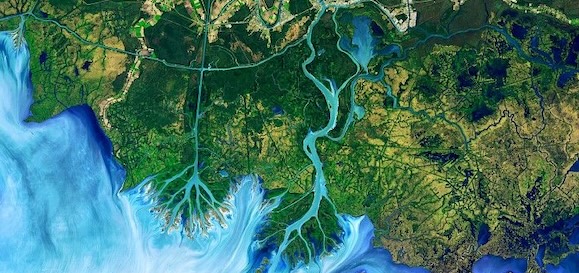
Feature image from LandSat. Image credit: Joshua Stevens/NASA Earth Observatory
List of experiences
Request Process and Form
Faculty Developer and Host: Dr. Xiaojing Tang, Geography

Spring semester availability
Feb 12- March 6 and March 27-April 10, not available April 5th
Mondays and Wednesdays, 9-11; Fridays 9-11 and 11:30-1:30
Description
To Share with Your Students Before the Visit
One or both of these short videos
Overview of What your Students will be Doing
- Start with a brief introduction to remote sensing and satellite imagery
- A fun exercise of guessing where the images are taken and what is in the images
- Observe how humans have transformed the landscape using Google Earth Engine Time-lapse
- Split into groups and work on mapping specific types of changes
- Assess the accuracy of the maps
- Presentation of the results
- Closing remarks
Differentiation
Helpful Background Knowledge
- Experience looking at satellite images on Google Earth/Map
- Familiar with geography, natural resources, and human development
- Entry-level training in GIS would be great, but not required
Transferable STEM Skills Practiced
Quantitative reasoning: Students will use accuracy assessment to quantify the accuracy of their maps.
Data interpretation/analysis: Students will practice visual interpretation of satellite images, and perform image processing and classification on the images.
Data visualization: Students will visualize the satellite images and the change maps they made
Scientific communication: Students will be asked to present their results.
Cross-Disciplinary Connections
Connections to Dr. Tang's Teaching and Research Interests
Examples of Connections to Solving Real-World Challenges
Related Careers
Remote sensing scientist applies remote sensing principles and methods to solve real-world problems such as resource management, urban planning, climate modeling, and ecological forecasting.
Geospatial Intelligence Analysis uses aerial, satellite, and drone imagery to extract and collect intelligence critical to our national security.
